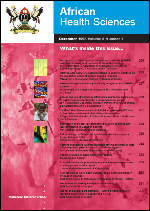
|
African Health Sciences
Makerere University Medical School
ISSN: 1680-6905
EISSN: 1680-6905
Vol. 18, No. 3, 2018, pp. 727-736
|
 Bioline Code: hs18090
Bioline Code: hs18090
Full paper language: English
Document type: Study
Document available free of charge
|
|
|
African Health Sciences, Vol. 18, No. 3, 2018, pp. 727-736
| en |
Status of thiocyanate levels in the serum and saliva of non-smokers, ex-smokers and smokers
Madiyal, Ananya; Ajila, Vidya; Babu, Subhas G; Hegde, Shruthi; Kumari, Suchetha; Madi, Medhini; Achalli, Sonika; Alva, Priyadharshini & Ullal, Harshini
Abstract
Background: Use of tobacco is often implicated in the development of oral diseases. Questionable accuracy of the traditional
questionnaires to assess cigarette exposure necessitates the use of biomarkers like thiocyanate which provide a definitive quantitative measure.
Objective: To assess the rise in the level of thiocyanate for measurement of smoking behaviour in adults.
Materials and methods: Serum and salivary thiocyanate levels were estimated in 20 non-smokers, 20 ex-smokers and 40 smokers. Smokers were divided into two groups based on the presence or absence of oral mucosal lesions.
Results: The mean serum and salivary thiocyanate levels were increased significantly in smokers when compared to non-smokers and ex-smokers. The levels were not significantly different between ex-smokers and non-smokers and between smokers
with tobacco related oral mucosal lesions and those without. Statistically significant correlation was seen between the serum and
salivary levels of thiocyanate.
Conclusion: This study highlights the high level of thiocyanate in the serum and saliva of smokers when compared to non-smokers and ex-smokers. Significant increase in thiocyanate level was also seen in saliva. Hence it can be stated that saliva can be used
as a reliable, non-invasive tool to assess smoking behaviour in the population and its changes over time.
Keywords
Thiocyanate; Tobacco; Smoking; Cancer; Pre-cancer.
|
| |
© Copyright 2018 - Madiyal et al.
|
|
